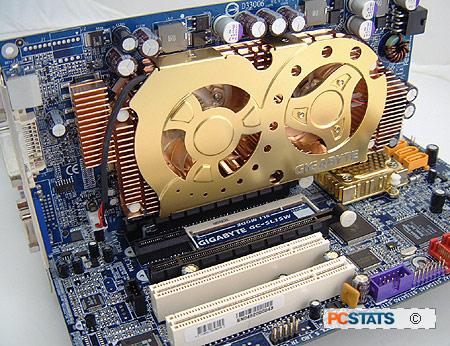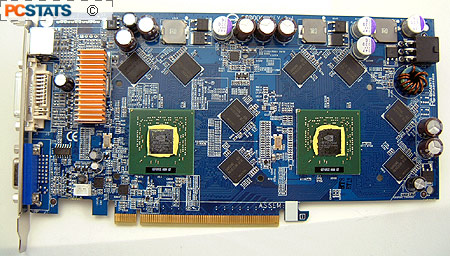nVIDIA's
new SLI (Scalable Link Interface) technology is used to link two nVIDIA based
cards together, splitting the rendering load between them to increase 3D
performance. The technology requires a pair of compatible videocards (nVIDIA
Geforce 6600GT models and above) with SLI connectors (must be implemented by the
video card manufacturer) and an Nforce 4 SLI chipset-based motherboard.
Typical
PCI-Express-based motherboards use the PCI-Express x16 slot to interface with
video cards. As you'd imagine, this provides 16 PCI Express lanes to the single
card for a total available bandwidth of 8GB/s. The nVIDIA Nforce 4 SLI solution
provides two physical PCI-Express video slots, and uses a switch to divert 8
PCI-Express data lanes to serve each slot. A single card can also be used in
either slot, and in this case the full 16 PCI-Express lanes are available. In a
typical SLI solution, the cards themselves are also linked by way of an SLI
cable attached to the special MIO 'video bus' connector on the top of each card.
 nVIDIA's
SLI works by allowing the two graphical processors to share the rendering
workload, governed by the nVIDIA Detonator software drivers. The CPU passes all
neccessary 3D information to the 'primary' GPU, which then shares the
information with the second card via the video bus interface cable. This removes
the overhead of synchronizing the two processors from the PCI-Express bus,
allowing improved performance. The video bus link itself apparently runs at up
to 10GB/s, though we doubt that this bandwidth is fully utilized.
nVIDIA's
SLI works by allowing the two graphical processors to share the rendering
workload, governed by the nVIDIA Detonator software drivers. The CPU passes all
neccessary 3D information to the 'primary' GPU, which then shares the
information with the second card via the video bus interface cable. This removes
the overhead of synchronizing the two processors from the PCI-Express bus,
allowing improved performance. The video bus link itself apparently runs at up
to 10GB/s, though we doubt that this bandwidth is fully utilized.
The major
benefit of nVIDIA's SLI is its ability to more fully utilize the
massive bandwidth of the PCI-Express x16 video solution. A pair
of GPUs can process information twice as fast (minus the overhead of the
communication between them) and use the available bandwidth more efficiently, considerably boosting
3D performance. This should also enable users to get top-tier performance
out of a pair of mid-range 6600GT cards.
Gigabyte special SLI implementation
Gigabyte's unique
SLI solution, as seen in the GV-3D1, approaches the technology from a different angle. Instead of
two separate cards, two GPUs (6600GTs in this case) are
combined on a single card, each with its own separate video memory and memory
bus.

An onboard interface replaces the video bus SLI connector,
but the two GPUs otherwise operate just as they would if they were on different
cards. The major difference comes in the configuration of the motherboard,
and this explains why the GV-3D1 currently only works with (and is bundled
with) Gigabyte's GA-K8NXP-SLI board. The 16 PCI-Express lanes within the single
slot that accepts the Gigabyte card are switched so that 8 feed each GPU on the
GV-3D1. Compatibility with other motherboards may become available in the
future, but for now Gigabyte plans to sell the GV-3D1 and the K8NXP-SLI together
only.
